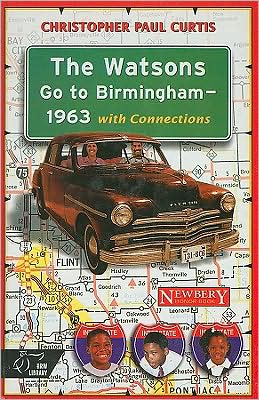Watsons go to Birmingham - 1963

Curtis, C.P. (1995). The Watsons go to Birmingham, 1963. New
York, NY: Holt, Rinehart and Winston.
This story is
about the Watsons from Flint, Michigan.
There are three kids, Bryon the oldest, is in the sixth grade, Kenny,
the narrator, is in fourth grade, and their little sister, Joetta (Joey) who is
in kindergarten. Unfortunately, Kenny is
picked on by bullies led by Larry Dunn.
A new kid named Rufus comes to Clark Elementary and becomes friends with
Kenny. Bryon gets into trouble at school
and then mom and dad decide that it is time to go and visit Grandma Sands in
Birmingham, Alabama to have Bryon learn how to behave. The family is enjoying themselves at
Grandma’s and Bryon is being nice. Tragedy
strikes for the Watsons, when Joey goes to church with neighbors and a bomb
goes off there at the church. The whole
family is worried that Joey was in the church when the bomb went off. Joey shows up at Grandma Sand’s house and
says that she was never in the church when it happened. The family decides to go back home after
that. Kenny is taking the bombing the
hardest because, he has never encounter racism before. Bryon takes it upon himself to comfort and
try to explain to Kenny that it wasn’t his fault and that he will be
alright.
The story takes
place in 1963 when racial tension was high and the civil rights movement was in
the news. The family lives in Flint, Michigan
then they travel to Birmingham, Alabama where things are different for the
Watson family. The setting in the story
has an impact on the family and the events that occur changes them.
Here is a link to a teacher's resource guide: http://www.hallmarkchannel.com/thewatsonsgotobirmingham/educatorsguide
Here is a link for a 5th grade study on the novel: https://www.readworks.org/lessons/grade5/watsons-go-birmingham%E2%80%941963
We are the ship
Here is a link to a teacher's resource guide: http://www.hallmarkchannel.com/thewatsonsgotobirmingham/educatorsguide
Here is a link for a 5th grade study on the novel: https://www.readworks.org/lessons/grade5/watsons-go-birmingham%E2%80%941963
We are the ship
Nelson, K. (2008). We are the ship. New York, NY: Hyperion.
Kadir Nelson takes
readers through the beginnings of the Negro Baseball League that was founded in
the 1920’s by Rube Foster. We are
introduced to great players such as Satchel Paige, Josh Gibson, and Biz
Mackey. We learn about how they were
mistreated, faced discrimination, received low pay and had to endure rough
conditions on the road. These unsung
heroes played because they loved the sport.
They played ball in a totally different way and they made some changes
in the game that carried over to the majors.
Once Jackie Robinson crossed over into the majors in 1947, the Negro
Baseball League began coming to an end.
Unfortunately, many great players were never given a chance to play majors
but played hard and with their hearts on their sleeves.
Nelson's style is very evident in his book. The oil paintings that he created fit beautifully with his story. You can actually see their love, their determination and their emotion in their faces. Nelson goes into such details when he describes the hardships of the players and how it moves along from their unacceptance to their acceptance into the majors. This theme is evident throughout the story. Nelson ends this beautiful tale with the list of the Negro players that made it to the majors and those who made it to the National Baseball Hall of Fame.
Nelson's style is very evident in his book. The oil paintings that he created fit beautifully with his story. You can actually see their love, their determination and their emotion in their faces. Nelson goes into such details when he describes the hardships of the players and how it moves along from their unacceptance to their acceptance into the majors. This theme is evident throughout the story. Nelson ends this beautiful tale with the list of the Negro players that made it to the majors and those who made it to the National Baseball Hall of Fame.
Here is a link to a 4th grade unit:
http://cep01.managed.contegix.com/download/attachments/2294710/ELA_G4_WeAreTheShip_POST-PROOF_082913.docx?version=1&modificationDate=1378580850092&api=v2
Here is a link to great resources on the
novel: http://cep01.managed.contegix.com/download/attachments/2294710/ELA_G4_WeAreTheShip_POST-PROOF_082913.docx?version=1&modificationDate=1378580850092&api=v2
Good masters, sweet ladies!
Schlitz, L.A. (2007). Good masters, sweet ladies. Boston, MA:
Candlewick Press.
This book introduces
you to children of a medieval village in England in the year 1255. It is written in a series of monologues and
dialogues of 20 children from a various social classes. Some of the characters interact with one
another but what is interesting is that they either live in or near the same
medieval manor. Characters range from Isobel,
the lord’s daughter to Pask, the runaway boy.
Each character tells their story and it is interesting to hear their perspective
of their life and we learn how they were treated, what they did and how they
felt. Schlitz also provides the readers
with narratives about the Three-Field System, the Medieval Pilgrimage, the
Crusades, Falconry, Jews in Medieval Society, Towns and Freedom. This also gives readers background
information to better understand each of the characters.
Schlitz’s style is
very important because of how she wrote the book. She wrote it in a series of plays. Because of this, you are able to hear each character’s
voice and see how difficult their life was during medieval England. The illustrations and the font help with the
telling of the stories. There is an
overall theme in the book that children from medieval times also had
difficulties to overcome and that children of today can relate to it as well in
their lives.
Students can do Reader's Theater with the characters from the novel and learn about the different jobs of the people who lived during the Medieval period: http://www.worldchesshof.org/uploads/2012/08/10/pawn58ca.pdf
Here is a link for teacher's resources based on the novel: http://www.socstrpr.org/files/Vol%204/Issue%203%20-%20Winter,%202010/Features/4.3.10.pdf
No comments:
Post a Comment